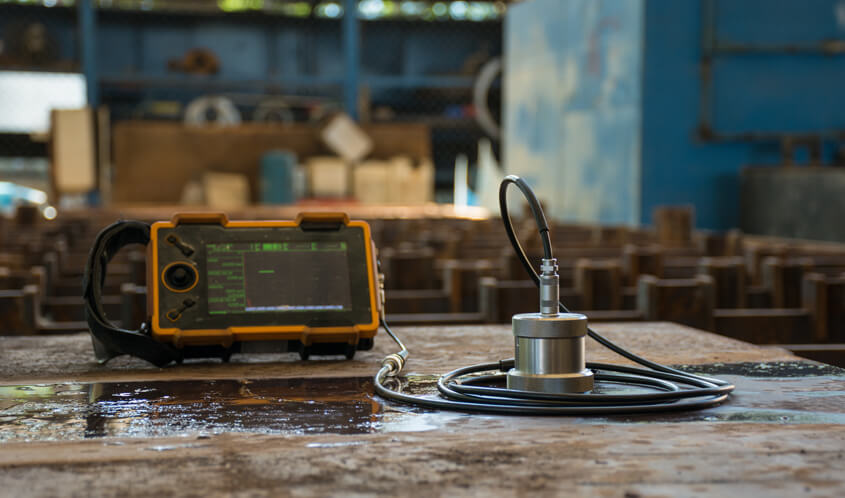Working Principle of Ultrasonic Testing
Ultrasonic testing employs high frequency sound energy to conduct examinations and make evaluations. In this technique, high frequency sound waves in the range of 0.1 MHz to 25 MHz are introduced into the material or object under evaluation using transducers. These ultrasonic waves propagate through the material and can detect discontinuities, cracks, inclusions or voids. When the ultrasonic waves encounter an imperfection they are reflected back to the surface. The time interval between introduction of pulse and return of echo is measured and evaluated to reveal internal flaws and characterize material properties.
Ultrasonic testing works on the principle of reflection and refraction of sound waves at material interfaces and boundaries. The transducers convert electrical pulses into mechanical vibrations which are introduced into the test material as ultrasonic sound waves at normal or oblique incidence. Factors like density, homogeneity, grain structure and thickness variations determine how ultrasonic waves are reflected or scattered back to the transducer. By measuring important wave parameters like time of flight, amplitude and sound velocity, crucial material data can be extracted.
Equipment Used
The basic Ultrasonic Non-Destructive Testing Equipment required for ultrasonic testing includes pulser-receiver units, transducers, coupling agents and defect indicators. Pulser-receiver provides electrical excitation to introduce ultrasonic waves through transducers. Both contact and immersion transducers made of piezoelectric materials are available for transmitting and receiving ultrasound. Transducers are applied using coupling agents like grease or water to ensure propagation. Defect indicators or oscilloscopes are employed to visualize returned pulse-echo or through transmission signals for flaw detection and analysis. Sophisticated systems with automated scan units and data analysis software have also been developed.
Heating, Ventilation, and Air Conditioning (HVAC) Systems
Ultrasonic testing finds extensive use in HVAC industry for inspection of heat exchangers, chillers, boilers, tanks and pipes. Internal corrosion, fouling or cracking can reduce heat transfer efficiency and lead to leaks, thereby escalating maintenance costs if not detected early. Periodic ultrasonic examination helps monitor material degradation over time and schedule timely maintenance activities. Ultrasonic thickness measurement is conducted to assess corrosion rates and residual material integrity. Tube sheets and tube bundles are evaluated for flaws. This non-destructive method effectively detects defects without causing downtime or service interruptions.
Aerospace Industry
Aircraft safety heavily relies on regular NDT inspection of critical components like aircraft engines, turbines, landing gears, hydraulic systems and composite structures. Due to stringent airworthiness regulations, 100% volumetric inspection of assembled parts and those involving weld joints must be ensured. Ultrasonic phased array technique permits rapid scanning of large areas with high resolution. Immersion testing examines jet engines, while composites are tested using angle beam probes. Life assessment of high pressure vessels is carried out through ultrasonic thickness gauging. This helps determine remaining operational life and reduce maintenance overhauling costs.
Construction and Weld Inspection
In building constructions, pre-stressed concrete elements, bridge structures and other load bearing members require non-destructive evaluation to ensure safety and code compliance. Ultrasonic testing effectively detects internal cracks, voids and delamination that may develop over years of service. It plays a vital role in weld quality control to verify flaw free joints. Automated ultrasonic weld inspection systems allow 100% examination of pipe assembly welds. This minimizes rework risks and provides quality certifications for pipelines, pressure vessels and offshore structures in oil & gas industry.
Power Generation
Steam turbines, gas turbines, nuclear reactors and other core equipment in power plants undergo rigorous non-destructive testing to maintain operational safety and performance. Ultrasonic thickness measurement monitors material loss in critical sections of boilers, condensers and pressure vessels that are susceptible to high temperature corrosion over long duty cycles. Rotating shaft components are inspected for cracks or wear using ultrasonic rotating probes. Tube-to-tubesheet joints are checked for sound bonding. This keeps unplanned downtimes at bay and extends component life.
Transportation
Ultrasonic inspection plays a pivotal role in maintaining integrity of rail infrastructure by detecting internal defects in rails and wheels before failures occur. This helps boost safety of rail transport. In road transports, axles, springs, frames and other undercarriage parts are examined to prevent accidents from unexpected structural damage. Marine vessels rely on ultrasonics to check plates, welds and critical piping for corrosion related flaws under wet conditions. This conforms to statutory regulations on periodic NDT of vessels.
Advantages
Some key advantages of ultrasonic NDT include high detection accuracy, versatility, reproducibility and reliability of results. It facilitates precise characterization of defect geometry, orientation and depth. Unlike radiography, it does not use any harmful radiation. Ultrasonic testing is suitable for complex geometries and can operate in challenging environmental conditions like high humidity, dust or where direct visual access is restricted. Advanced automated scanning systems and data analytics tools now allow rapid high resolution inspection of large areas and volumes with reproducible precision. This removes human errors and improves productivity. Portable equipment promotes on-site testing with mobility.
*Note:
1. Source: Coherent Market Insights, Public sources, Desk research
2. We have leveraged AI tools to mine information and compile it

